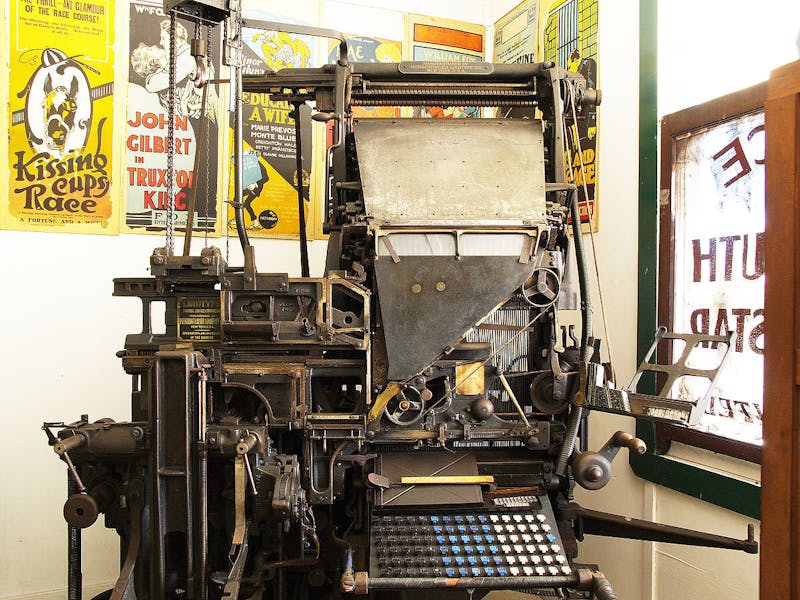
ULRICH LANGE / CC BY 2.0
When Hocherman worked at The News-Letter, the paper was set in “hot type” on a Linotype machine.

ULRICH LANGE / CC BY 2.0
When Hocherman worked at The News-Letter, the paper was set in “hot type” on a Linotype machine.
I joined The News-Letter as a freshman in 1964. One of my assigned tasks, in addition to turning out profound, satirical, highly principled journalistic gems, involved going to our printing plant on Thursday evenings to proofread, an odious task reserved for rookies.
In the 1960s, The News-Letter (like most newspapers in America) was set in “hot type” on a Mergenthaler Linotype, a massive, noisy, machine that turned liquid lead into lines of type. The heart of the machine was a pot of molten metal. Its brain was a human being working a keyboard. Connecting the two was an ingenious Rube-Goldbergian train of gears, wheels, belts and pulleys, controlled by the rotation of a single giant cam — the product of a brilliant Victorian mechanical mind. Mergenthaler had once been apprenticed to a watchmaker.
The print shop was in an old building on “B” Street in Baltimore’s red light district. I arrived with a sheaf of last-minute typescript in my hand to deliver to the Linotype operator. The Linotype sat in its own, hot, windowless room; the molten lead maintained at a temperature of 535 degrees Fahrenheit.
The linotypist, who I will call Hal, was perched atop a tall stool. Hal was a very large man with long arms, and it strikes me now that his proportions were appropriate to the mass of the instrument he was playing. He wore an ink-stained T-shirt and had an open family-sized bottle of Coke sitting to the right of the keyboard. When I arrived he was immersed in his work and continued on as if I were not there.
The Linotype keyboard was very wide and had 90 keys arranged in three sections of 30 keys each. There was no “shift” key. The left section (black keys) produced lowercase letters. The right section (white keys) produced upper case letters. The center section (blue keys) produced everything else. The keys were not arranged in the familiar “qwerty” pattern. Instead, the letters were arranged vertically in columns of six in the order of frequency in which they appear in English, starting with “e.”
I settled down to wait for Hal to notice me and began watching him at his work. It was mesmerizing. He played the broad keyboard as a virtuoso plays a Steinway, his hands floating over the keys with a grace that belied his size. While the machine clattered and wheezed its robotic rhythm, it appeared that Hal was playing a sonata of his own composition, a melody that only he could hear. The end of each line of text was accompanied by a tune of its own as the matrices Hal had just assembled were sent on their journey to the casting section of the machine, there to be bathed in molten metal and give birth to a shiny new line of type. At times Hal would take a slug from the bottle of Coke, never breaking his rhythm.
At odd intervals, without a noticeable cue, Hal would reach across and run his right hand down the leftmost two columns of black keys, as though playing a tune-less vertical glissando.
The finished lines of type were moved to a composing room where they were assembled with photographs, cartoons and ads and locked into a galley from which a proof was printed. Equipped with a red pencil and a cup of coffee, I started proofreading. Suddenly, in the midst of an otherwise perfect column, there appeared the mystical incantation “etaoin shrdlu.” The password of a secret society? A Gaelic curse? The same phrase was repeated twice more that day. I flagged it as a typo each time and the line was duly replaced.
I made many more visits to the printer that year, and I always took pleasure in watching Hal work. The Coke bottle was always there, as was the serpentine fluidity that marked the movements of his hands as he played his tunes on the tricolor keyboard. He was a virtuoso of a dying art. Neither he nor I suspected that before the end of the next decade, the Linotype, essentially unchanged since 1884, would be no more.
By my sophomore year, I had aged out of the proofreading rotation and had moved on to editing. My four years on The News-Letter brought their share of adventure. I covered then-President Lyndon B. Johnson’s “Peace Without Conquest” address in April 1965. I was nearly arrested for writing a piece that a sergeant of Baltimore police found offensive (“Liquor Laden Lads Foment Fuzz Fury”). I reported a cross-burning on the Hopkins campus in March of 1966. Still, in thinking back on those lovely years, the long nights of proofreading on Baltimore Street stand out most vividly.
By the time I went on to law school and 40 years of law practice, proofreading had become a habit I could not shake. To this day I read my emails twice before hitting “Send.”
About “etaoin shrdlu.” Linotypists could not “undo” their mistakes. It became the universal practice of Linotype operators to address their errors by running down the first two columns of the keyboard, etaoin shrdlu, to complete the line and flag the error for the proofreader. Sometimes the phrase made it to print. The New York Times edition of July 2, 1978 was the last to be set in hot type, thus ending the age of the Linotype. A documentary filmed that day in the Times’ printing plant was titled Farewell, Etaoin Shrdlu.